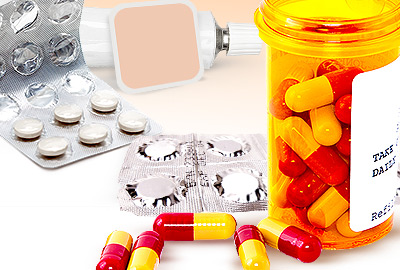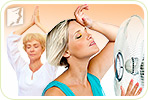Due to their unpredictable nature, finding adequate treatment for hot flashes can be quite challenging. Fortunately, with diligence and patience, long-lasting relief from menopause hot flashes is within reach.
Read on to discover the best treatments for hot flashes so that you can choose the one that is best for your reproductive health and pass through this life phase more freely.
Three Approaches for Treating Hot Flashes
There are three levels of treatment for hot flashes: (1) Lifestyle Changes, (2) Alternative Medicine, and (3) Medications. It is generally recommended to begin with the most natural approaches, such as lifestyle adjustments and herbal supplements, and move on to invasive treatments only if necessary.
Lifestyle Changes for Hot Flashes

Lifestyle changes are the first level of hot flashes treatment. While this method is virtually risk-free, it does require the greatest amount of self-discipline and commitment.
Nutritious Diet
Keeping a healthy diet should not be underestimated in hot flashes treatment. When composing their meals, women should choose healthy fats, slow-release carbohydrates, and lean protein that are rich in the following compounds:
- Phytoestrogens act as the body's own estrogen to resolve hormonal imbalance and reduce hot flashes.
Soy beans and soy products, flax, lentils, chickpeas, yams, garlic
- Vitamin E helps maintain healthy blood vessels and can significantly reduce the severity and frequency of hot flashes.1
Sweet potatoes, almonds, spinach, sunflower seeds, broccoli
- Vitamin C, a potent antioxidant, has been found to strengthen blood vessels, aiding in the prevention of hot flashes.1
Oranges, berries, kiwi, bell peppers, broccoli, dark green leafy vegetables
Water during the menopausal transition helps prevent dehydration and aids in reducing the frequency of hot flashes. The general recommendation is to drink six to eight cups of water daily.
In hot flashes treatment, avoiding foods that are known to trigger hot flashes, like alcohol, caffeine, or spicy foods, is equally important as loading up on those that relieve them.
Regular Exercise
Although the thought of exercising might be revolting to those who have experienced a hot flash at least once, studies have shown that women who exercise regularly experience less hot flashes and report lower severity and duration of individual episodes.2
Amount: The goal is to get at least 150 minutes of low to moderate level activity per week, which can be broken up into 30-minute workouts five times a week.
Type: Training should comprise of aerobic exercises, like biking, dancing, or jogging, with muscle-strengthening exercises with light weights or resistance bands. Pilates and yoga are also great options.
Useful Tips: Exercising in well-ventilated spaces with open windows, fans, or air-conditioning might make the workouts more pleasant. Going out for a jog or a walk during cool weather is also a good approach.
Precautions: Middle-aged women are advised to stay away from extreme physical activities, like heavy weight lifting or endurance training.
Wholesome Habits
Besides diet and exercise, women can implement various healthy practices that might help them keep their hot flashes at bay more effectively. They include:
- Lowering stress is a natural hot flashes treatment. Prolonged stress elevates cortisol levels, which keeps the body in “fight or flight mode” and increases perspiration, breathing, and heart rate, thus provoking hot flashes.3
Common stress-relief methods include meditation, acupuncture, deep breathing, aromatherapy, or yoga.
Quitting smoking as well as alcohol and excess caffeine drinking can hugely reduce the frequency of hot flashes. Smokers have been observed to have more drastically uneven ratios of estrogen to androgens, which is linked to more frequent hot flashes.4
- Learning coping strategies and trigger avoidance can also come in handy when hot flashes strike.
Strategies for managing hot flashes may include wearing breathable fabrics, avoiding synthetic clothes, adjusting the thermostat, or applying cold compresses.
Alternative Treatments for Hot Flashes

Alternative approaches comprise the second level of hot flashes treatment. They involve little to no risk, and most women find that herbal supplements are one of the best regimens to follow as they treat the hormonal imbalance directly at the source.
The two types of herbal supplements that can be an essential addition to a treatment plan for hot flashes include:
Phytoestrogenic Supplements
Phytoestrogenic supplements are made from plants, such as black cohosh, ginseng, or red clover, which contain estrogenic components. At first, these herbs do treat the underlying estrogen imbalance behind hot flashes by introducing these plant-based estrogens into the body. However, as a result of outside hormones being added, the body may become less capable of producing estrogen on its own. This causes a further decrease in the body's own hormone levels.
Hormone-Regulating Supplements
Hormone-regulating supplements are made from plants that do not contain any estrogen. Instead, they nourish the endocrine glands, causing them to produce natural hormones more efficiently. This ultimately results in balancing not only estrogen, but also other hormones, such as progesterone. Hormone-regulating supplements, like Macafem, can be regarded as a safe and effective way to treat hot flashes naturally and bring about hormonal equilibrium.
From Nature and Health Magazine, Dr. Chacon says:
"Macafem's nutrients help restore natural hormones in women. Unlike hormone drugs, which are basically resumed in taking synthetic hormones, Macafem acts totally different in your body. It nourishes and stimulates your own natural hormone production by inducing the optimal functioning of the pituitary and endocrine glands." Click on the following link to learn more about Macafem
A combination of lifestyle changes and herbal supplements is usually the most effective route to take in hot flashes treatment. For some women, however, menopausal symptoms are severe enough to necessitate the third and most risky approach, namely medications.
Medications for Hot Flashes

Interventions at the third level typically involve the highest risk and often the highest costs. As such, a thorough evaluation of symptoms and research about potential side effects is needed to ensure they do not outweigh the benefits and put a woman's health in jeopardy.
The most common medications for treating menopause hot flashes are as follows:
Hormone Replacement Therapy (HRT)
HRT - containing estrogen, progesterone, or their combination - used to be the go-to treatment for hot flashes during the menopause transition. Without a doubt, HRT can quickly and effectively relieve bothersome hot flashes. However, it entails serious side effects and increases certain health risks, as the following studies have shown.
In 2019, researchers at Oxford University published results of a comprehensive analysis of worldwide data on HRT's link to breast cancer. They confirmed the 2002 findings of the Women's Health Initiative, the largest clinical trial on HRT, which were published in JAMA and showed that HRT increases the risk of breast cancer, ovarian cancer, blood clots, and strokes.5 Their results, published in The Lancet, also showed that HRT risks can persist for over a decade after its discontinuation.6
Other Medications for Hot Flashes
In addition to HRT, several other pharmaceutical drugs may serve as hot flashes treatment options, including:
Antidepressants, or selective serotonin reuptake inhibitors (SSRIs), prescribed in low doses can relieve hot flashes in women who do not want to or cannot undergo HRT.
Blood pressure medications in a pill or as a skin patch can reduce the severity of hot flashes in some women.
Anti-seizure medications may bring relief from hot flashes and their nocturnal version, night sweats.
Studies have also shown that cognitive-behavioral therapy can help alleviate hot flashes, night sweats, depression, and other menopause symptoms.7
These three levels of hot flashes treatment are not mutually exclusive. During the menopausal transition, women may naturally move between various approaches, depending on the duration and severity of their symptoms. Nevertheless, they most commonly find the best and safest relief through a combination of healthy lifestyle changes and alternative treatments without ever having to reach for conventional ones.
A Safe Treatment for Hot Flashes
Implementing Lifestyle Changes:
- Eating a diet with foods rich in phytoestrogens and vitamins E and C
- Exercising in well-ventilated spaces 5 times a week, 30 min a day
- Avoiding alcohol, tobacco, caffeine, spicy foods, and high stress
- Wearing breathable clothes and cooling off with cold compresses
And Taking Herbal Supplements:
- Phytoestrogenic herbal supplements, like black cohosh or red clover
- Or natural hormone-regulating supplements, like Macafem
Sources
- Cleveland Clinic. (2017). Menopause: Non-Hormonal Treatment and Relief for Hot Flashes. Retrieved January 8, 2019 from https://my.clevelandclinic.org/health/articles/15223-menopause-non-hormonal-treatment--relief-for-hot-flashes
- Mayo Clinic. (2018). Hot flashes - Diagnosis and treatment. Retrieved January 8, 2019 from https://www.mayoclinic.org/diseases-conditions/hot-flashes/diagnosis-treatment/drc-20352795
- National Health Service UK. (2015). Hot flushes: how to cope. Retrieved March 15, 2016, from http://www.nhs.uk/Livewell/menopause/Pages/hot-flushes.aspx
- National Institute on Aging. (2017). What Can You Do for Hot Flashes and Other Menopausal Symptoms. Retrieved March 15, 2016, from https://www.nia.nih.gov/health/publication/menopause-time-change/what-can-you-do-hot-flashes-and-other-menopausal-symptoms
- North American Menopause Society. (2018). Natural Remedies for Hot Flashes. Retrieved January 8, 2019 from https://www.menopause.org/for-women/menopauseflashes/menopause-symptoms-and-treatments/natural-remedies-for-hot-flashes
- Obstetrics and Gynecology Clinics of North America. (2011). Vasomotor Symptoms and Menopause: Findings from the Study of Women's Health Across the Nation. Retrieved January 30, 2020 from https://www.ncbi.nlm.nih.gov/pubmed/21961716
Footnotes:
- Journal of Mid-Life Health. (2013). The role of oxidative stress in menopause. Retrieved January 30, 2020 from https://www.ncbi.nlm.nih.gov/pmc/articles/PMC3952404/
- The Physiological Society. (2015). Exercise training reduces the acute physiological severity of post‐menopausal hot flushes. Retrieved January 30, 2020 from https://physoc.onlinelibrary.wiley.com/doi/full/10.1113/JP271456
- Menopause. (2005). The role of anxiety and hormonal changes in menopausal hot flashes. Retrieved January 30, 2020 from https://journals.lww.com/menopausejournal/Abstract/2005/12030/The_role_of_anxiety_and_hormonal_changes_in.6.aspx
- Obstetrics & Gynecology. (2009). Cigarette Smoking, Androgen Levels, and Hot Flushes in Midlife Women. Retrieved January 30, 2020 from https://www.ncbi.nlm.nih.gov/pmc/articles/PMC2673540/
- JAMA. (2002). Risks and benefits of estrogen plus progestin in healthy postmenopausal women: principal results from the Women's Health Initiative randomized controlled trial. Retrieved January 30, 2020 from https://www.ncbi.nlm.nih.gov/pubmed/12117397
- The Lancet. (2019). Type and timing of menopausal hormone therapy and breast cancer risk: individual participant meta-analysis of the worldwide epidemiological evidence. Retrieved January 30, 2020 from https://www.thelancet.com/journals/lancet/article/PIIS0140-6736(19)31709-X/fulltext
- Menopause. (2019). Cognitive behavior therapy for menopausal symptoms (CBT-Meno): a randomized controlled trial. Retrieved November 23, 2020 from https://journals.lww.com/menopausejournal/Abstract/2019/09000/Cognitive_behavior_therapy_for_menopausal_symptoms.6.aspx



